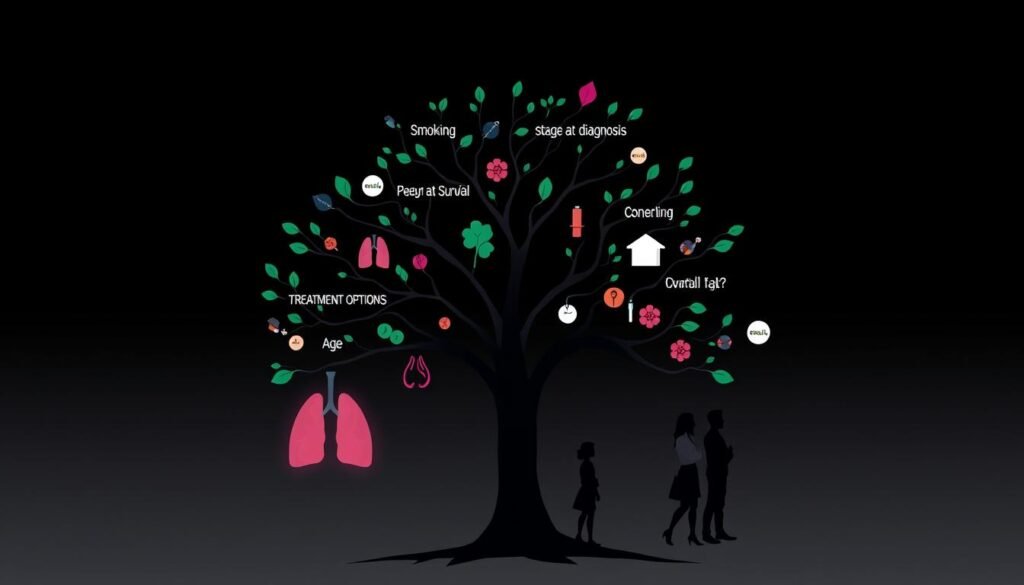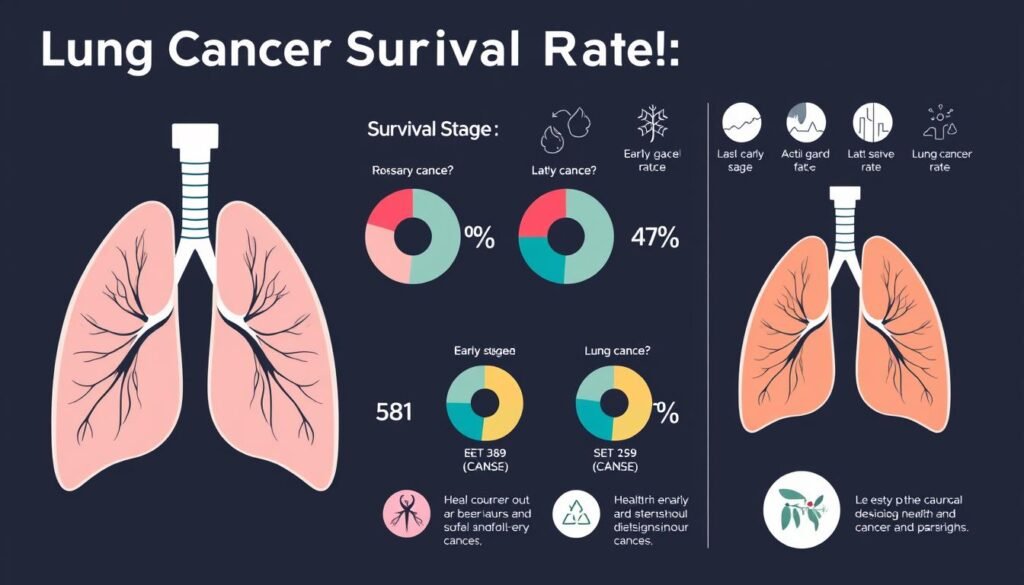Did you know the 5-year survival rate for lung cancer is about 37%? This low number shows how important it is to understand lung cancer survival rates. Understanding these rates means looking at many factors. These include the cancer type, how early it was found, and the patient’s background.
Knowing about survival rates helps with treatment choices and setting expectations. You can learn more about these statistics by checking the Cancer Society’s detailed documentation. Remember, these numbers are just estimates. They can’t predict exactly what will happen for each person.
Key Takeaways
- The overall 5-year survival rate for lung cancer is around 37%.
- Understanding survival rates can help guide treatment decisions.
- Different types and stages of lung cancer significantly impact survival rates.
- These statistics are derived from studies involving large patient cohorts.
- Survival rates should be seen as estimates rather than fixed outcomes.
Understanding Lung Cancer Survival Rates
Lung cancer survival rates show how people with this disease progress over time. They mostly look at survival over five years. These statistics help patients and families know what to expect.
Many factors can change these rates. They include the person’s age, health, and the cancer’s type and stage. The SEER Program by the National Cancer Institute says the average five-year survival rate is about 25.4 percent between 2013 and 2019. If the cancer hasn’t spread, the rate jumps to about 62.8 percent.
For cancer that has reached nearby lymph nodes, the rate is around 34.8 percent. But if it spreads to places like the liver, the chances drop sharply to 8 percent.
Knowing these numbers helps patients make informed choices. Talking with doctors about these rates can tailor treatment more closely. It leads to exploring things like early detection and new treatments. More information is in the Healthline article.
Five-Year Survival Rate for Lung Cancer
Lung cancer survival stats are key to grasping this tough illness. Reports show big differences in the five-year survival rate based on cancer type and stage. For instance, localized non-small cell lung cancer (NSCLC) has about a 63.7% five-year survival rate. This is much higher compared to distant stage NSCLC, which drops to around 9%. These numbers show how vital early detection is since early diagnoses can boost survival chances.
Overview of Survival Rates
The average five-year survival rate for lung cancer is around 18.6%. This includes all cases, with many diagnosed in late stages. Only 16% get spotted early on, which means most don’t have good odds. In fact, more than half of those diagnosed die within a year. This makes lung cancer the top killer among cancers. What’s more, very few people get screened for lung cancer, even if they’re eligible. Increasing screenings could save more lives. Checking for lung health is critical.
Importance of Relative Survival Rates
Knowing the relative survival rates for lung cancer is crucial. They compare lung cancer patients’ survival to people without the disease, putting treatment success into context. Good news is the five-year relative survival rate is getting better, especially in marginalized groups. The survival rate for people of color has gone up by 17% in two years. This progress shows the importance of tackling health disparities and making care accessible to everyone.

| Stage | Five-Year Survival Rate |
|---|---|
| Localized (NSCLC) | 63.7% |
| Distant (NSCLC) | 9% |
| Average (overall) | 18.6% |
| People of Color Improvement | 17% Increase |
Lung Cancer Survival Statistics
Understanding lung cancer survival stats shows big trends and key insights about patient outcomes over time. Thanks to better ways to find and treat it, more people with lung cancer are living longer. This progress in survival rates is important for patients and families.
Trends in Survival Rates Over the Years
Recent data shows lung cancer survival rates are going up. For example, the five-year survival rate between 2014 and 2020 was 26.7%. This is a big jump from 12.4% in the mid-1970s. The death rates from lung cancer are also dropping. This is thanks to better treatment options and finding the disease early.
Statistics from the American Cancer Society and SEER Database
The American Cancer Society expects around 234,580 new lung cancer cases in 2024. They will make up 11.7% of all new cancer cases. Sadly, lung cancer will be the cause of 125,070 deaths, about 20.4% of all cancer deaths. The SEER database provides more details. It says that the five-year survival rate for localized lung cancer is 63.7%. This highlights how crucial ongoing research and awareness are for lung cancer. Early detection plays a key role, too.
Lung Cancer Prognosis: What Affects It?
Knowing what affects lung cancer survival helps in understanding its prognosis. Key factors influence a patient’s outlook post-diagnosis. For instance, the type of lung cancer, like non-small cell (NSCLC) or small cell (SCLC), plays a big role in determining survival chances. The nature of the cancer also guides which treatments will work best.
Age matters too. Younger patients often fare better than older ones. The patient’s overall health and daily activity level, known as performance status, affects survival rates too. People in good health usually see better outcomes.
Genetic mutations impact how well certain treatments work, especially for adenocarcinoma patients. Knowing about these mutations is essential for planning the best treatment approach.

Here is a table showing survival rates based on lung cancer stage at diagnosis:
| Type of Lung Cancer | Stage | 5-Year Survival Rate |
|---|---|---|
| Non-Small Cell Lung Cancer (NSCLC) | Localized | 65% |
| Non-Small Cell Lung Cancer (NSCLC) | Regional | 37% |
| Non-Small Cell Lung Cancer (NSCLC) | Distant | 9% |
| Small Cell Lung Cancer (SCLC) | Localized | 30% |
| Small Cell Lung Cancer (SCLC) | Regional | 18% |
| Small Cell Lung Cancer (SCLC) | Distant | 3% |
Understanding these factors is crucial for both doctors and patients. It leads to better lung cancer management and patient care.
Lung Cancer Survival Rate by Stage
Knowing how the five-year survival rate for lung cancer changes is key. This change mainly depends on when the cancer is found. For both Non-Small Cell Lung Cancer (NSCLC) and Small Cell Lung Cancer (SCLC), the survival rates vary a lot by stage. These differences are crucial for deciding on treatments and predicting patient outcomes.
5-Year Survival Rates for Non-Small Cell Lung Cancer (NSCLC)
Non-Small Cell Lung Cancer makes up most lung cancer cases. Here are the five-year survival rates for NSCLC:
| Stage | 5-Year Survival Rate |
|---|---|
| Localized (Stage 1) | 64% – 90% |
| Regional (Stage 2) | 50% – 60% |
| Advanced (Stage 3) | 20% – 40% |
| Metastatic (Stage 4) | 3% – 9% |
5-Year Survival Rates for Small Cell Lung Cancer (SCLC)
Small Cell Lung Cancer usually has lower survival rates than NSCLC. Here are the five-year survival rates for SCLC:
| Stage | 5-Year Survival Rate |
|---|---|
| Localized | 29% |
| Regional | 18% |
| Metastatic | 3% |

These numbers show why catching lung cancer early is vital. The five-year survival rates for lung cancer can really vary. So, it’s crucial for patients and doctors to discuss treatment based on the cancer stage. Understanding survival rates by stage can aid in making wise decisions about care and management for those hit by this tough disease.
Lung Cancer Survival Rates by Type
Lung cancer comes in mainly two types: non-small cell lung cancer (NSCLC) and small cell lung cancer (SCLC). Knowing the survival rates helps understand how serious it is and what treatments might work best. NSCLC is the more common type and generally has better chances of survival than SCLC.
Comparison Between NSCLC and SCLC
The survival rates for NSCLC and SCLC are quite different. The 5-year survival rate for NSCLC is about 23%, while it’s only 6% for SCLC. When caught early, NSCLC has a 60% survival rate, much higher than SCLC’s 29%. This shows why finding lung cancer early can make a big difference.
Subtypes of Non-Small Cell Lung Cancer
NSCLC has a few types under it, such as adenocarcinoma, squamous cell carcinoma, and large cell carcinoma. Adenocarcinoma tends to have better survival outcomes. Knowing these types is key for doctors to choose the right treatment and for patients to know what to expect.
Treatment Options for Lung Cancer
Lung cancer treatment has grown a lot, giving patients better survival rates and quality of life. The treatment plan depends on the cancer type, stage, and the patient’s health.
Surgery is the key treatment for early-stage non-small cell lung cancer (NSCLC). It aims to remove tumors and prevent cancer from coming back. It’s best for tumors that haven’t spread.
Chemotherapy combines drugs to stop cancer cells from growing. Side effects include nausea, vomiting, hair loss, and tiredness. These side effects differ among patients.
For NSCLC, targeted drug therapy is more common now. It targets mutations in cancer cells, improving treatment results and patient survival.
Immunotherapy is another new treatment. It helps the immune system find and attack cancer cells. Its side effects can include tiredness and skin rashes.
Palliative care is crucial for improving life during lung cancer treatment. It eases symptoms like pain and breathing trouble, improving quality of life.
As treatments improve, managing side effects is key. Doctors prescribe medicine to help lessen discomfort and better the treatment experience.
| Treatment Type | Purpose | Common Side Effects |
|---|---|---|
| Surgery | Remove localized tumors | Shortness of breath, chest pain, fatigue |
| Chemotherapy | Stop cancer cell growth | Nausea, vomiting, hair loss, fatigue |
| Targeted Drug Therapy | Target specific mutations | Varies by medication |
| Immunotherapy | Activate the immune system | Fatigue, itchy rash, nausea |
| Palliative Care | Relieve symptoms | Varies based on individual needs |
Factors Affecting Lung Cancer Survival
There are many things that impact lung cancer survival. These include age, health before diagnosis, how you live your life, and your genes. Each of these factors has a big role in what happens to patients.
Age, Health, and Lifestyle Factors
Age is a big deal when it comes to beating lung cancer. Younger people usually have a better chance than older ones. How healthy you are before finding out you have cancer also matters. People who are healthier usually live longer after diagnosis.
What you choose to do every day, like if you smoke or not, really matters. Studies show that people who have never smoked live longer after lung cancer. This shows how much your daily choices can affect your chances.
Molecular and Genetic Factors
Genes and molecules play a bigger role in lung cancer now than ever before. If you have certain genetic traits, some treatments might work better for you. This means doctors can pick the best treatment for each person. This kind of personal care is changing how we fight lung cancer and can make a big difference in survival.
| Factor | Impact on Survival |
|---|---|
| Age | Older age generally correlates with poorer survival |
| Overall Health | Better health status leads to improved outcomes |
| Lifestyle Choices | Smoking cessation significantly enhances survival rates |
| Genetic Markers | Specific markers can lead to better-targeted treatments |
| Stage at Diagnosis | Higher stages (e.g., Stage IV) link to lower survival rates |
Improving Lung Cancer Survival Rates
Medical advancements and early detection are key in raising lung cancer survival rates. Efforts to improve treatments and diagnostics have a positive effect on survival statistics.
Advancements in Treatment
In recent years, there’s been great progress in lung cancer treatments. Targeted therapies and immunotherapy are giving new hope. They work on certain genes and boost the immune system’s fight against cancer, raising survival odds.
The Role of Early Detection and Screening
Spotting lung cancer early is essential for better survival chances. The U.S. Preventive Services Task Force suggests yearly screenings for people at high risk, using low-dose CT scans. Catching cancer early makes treatment more effective. Thus, screenings are vital for improving long-term outcomes and lowering lung cancer deaths.
Conclusion
It’s crucial for patients and their families to know the five-year survival rate for lung cancer. This knowledge highlights the importance of finding the disease early and the progress in treatments. In fact, patients found at an early stage have a 59% chance of survival after five years, well above the 22.6% average.
Age and gender play a role in lung cancer survival rates too. Women tend to live longer than men after a lung cancer diagnosis. The development of new treatments is offering personalized care. This means patients get treatments that are better suited for their specific condition.
To boost survival rates, we need ongoing education and research. Access to treatment must be equal for everyone. For more info on survival rates by stage and type, check out this detailed survival guide. These actions bring hope to lung cancer patients and their loved ones.